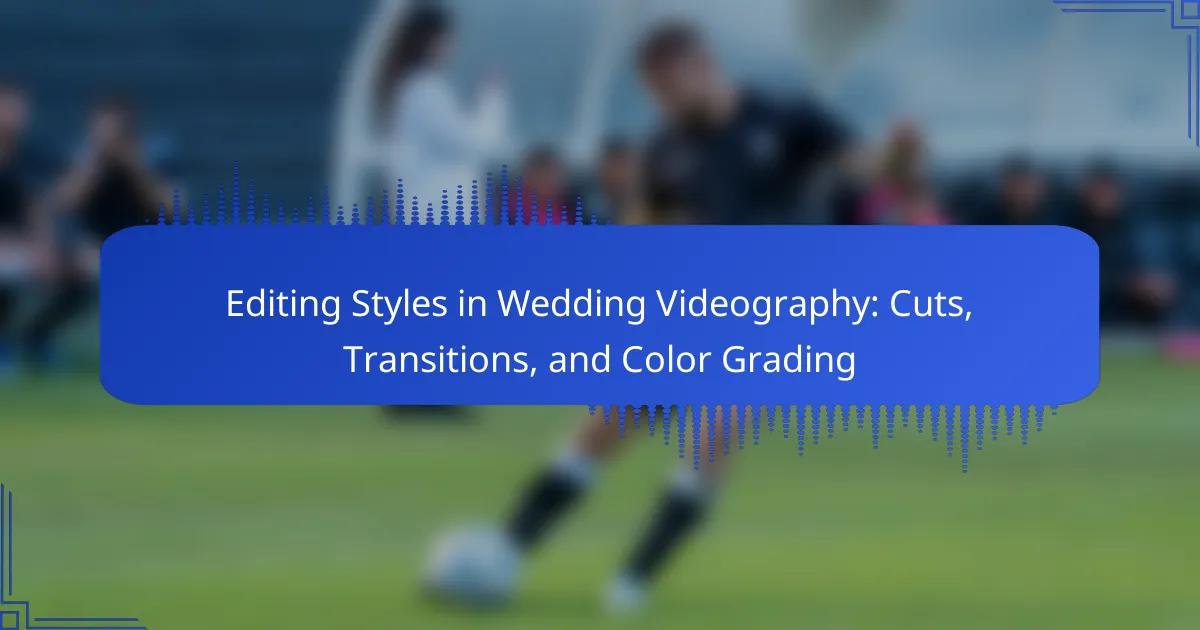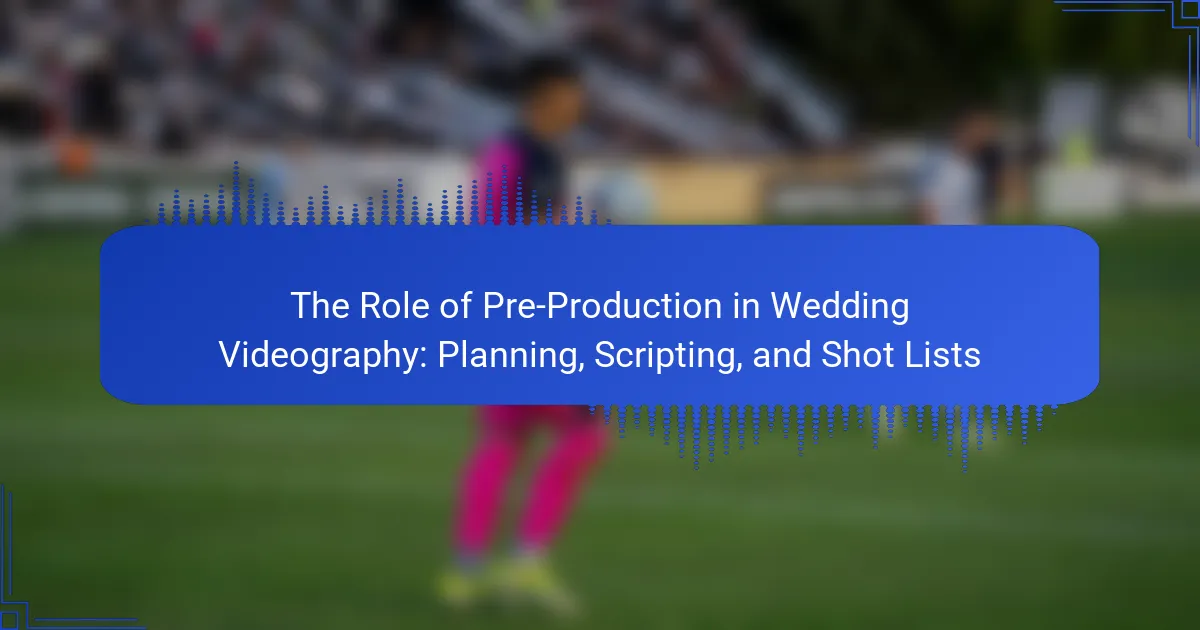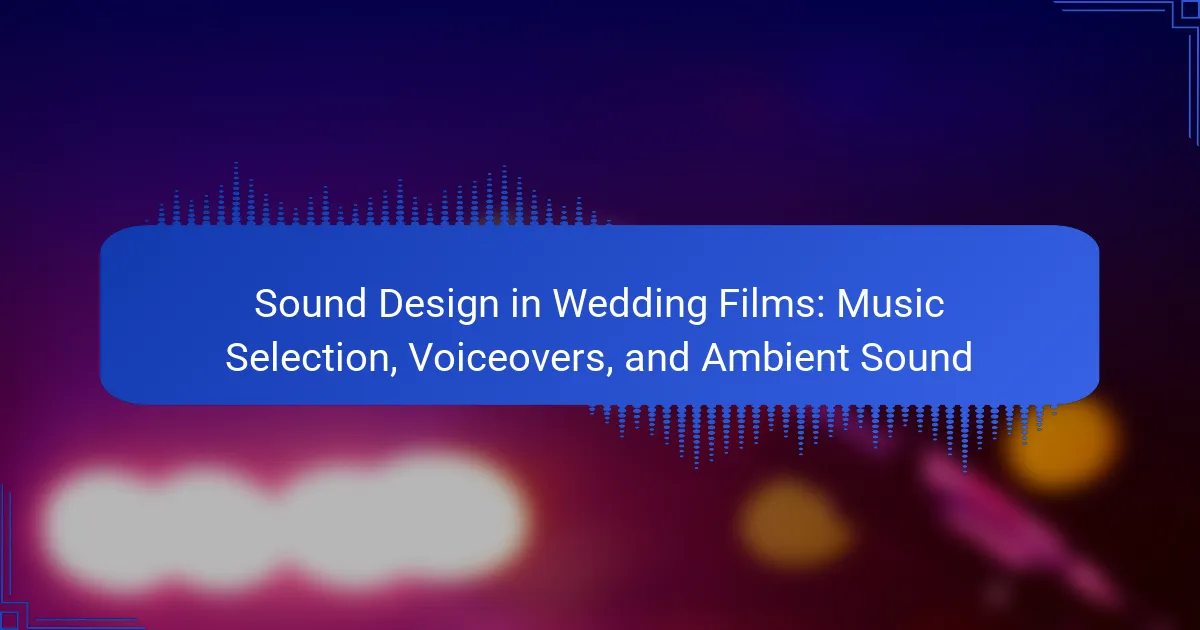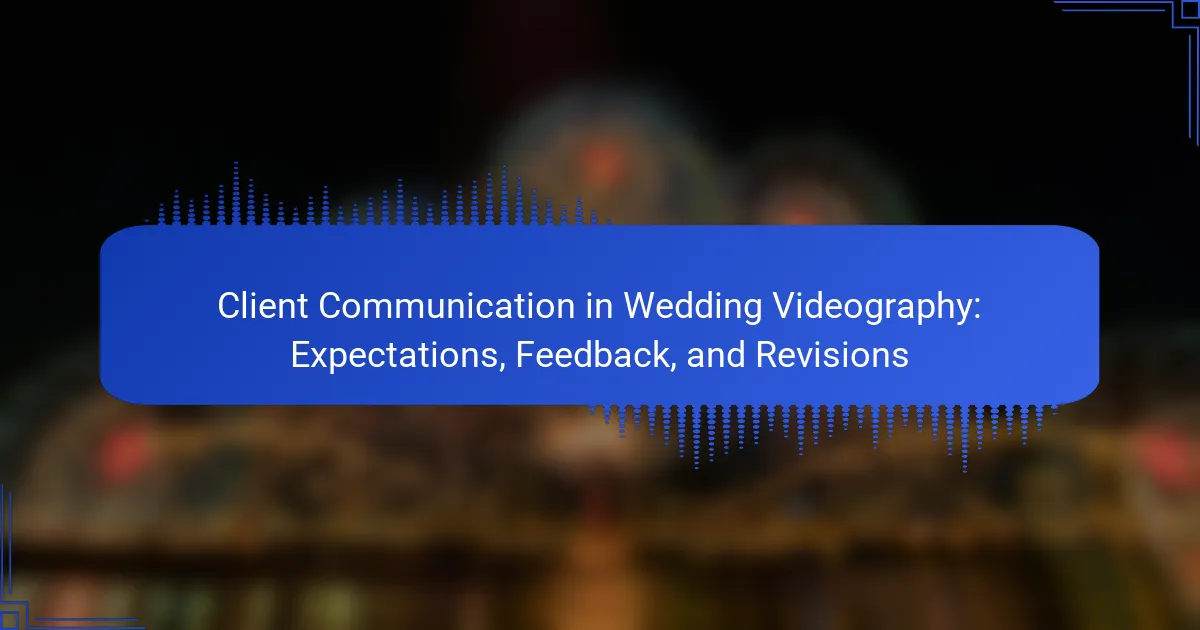Editing styles in wedding videography encompass various techniques used to assemble footage into a cohesive narrative, with common styles including documentary, cinematic, and highlight reel. Each style possesses distinct characteristics that shape storytelling, such as the authenticity of documentary style, the dramatic flair of cinematic style, and the concise engagement of highlight reels. Essential elements like cuts, transitions, and color grading play a critical role in enhancing visual appeal and emotional impact. Effective color grading adjusts tones to create mood consistency, while strategic cuts and smooth transitions contribute to thematic coherence. Understanding these components is vital for videographers to align their work with the couple’s vision and improve audience retention.

What are Editing Styles in Wedding Videography?
Editing styles in wedding videography refer to the various techniques used to assemble footage into a cohesive narrative. Common styles include documentary, cinematic, and highlight reel. Each style has unique characteristics that influence the storytelling approach.
Documentary style focuses on capturing events as they unfold, emphasizing authenticity. Cinematic style employs dramatic techniques, such as slow-motion and artistic shots, to create a film-like experience. Highlight reel style condenses key moments into a short, engaging video.
These styles often incorporate specific cuts, transitions, and color grading techniques to enhance the visual appeal. For instance, jump cuts may create a dynamic feel, while smooth transitions can maintain flow. Color grading sets the mood, influencing the overall aesthetic of the video.
Understanding these styles helps videographers choose the best approach for each wedding, ensuring the final product resonates with the couple’s vision.
How do editing styles influence the storytelling of wedding videos?
Editing styles significantly influence the storytelling of wedding videos. They shape how the narrative unfolds and how emotions are conveyed. For instance, a cinematic style often employs slow-motion shots to enhance emotional moments. Fast cuts may create a sense of excitement during the reception. Transitions between scenes can establish the flow of the story. Smooth transitions can evoke a romantic atmosphere, while abrupt cuts may add tension or surprise. Color grading also impacts storytelling by setting the mood. Warm tones can create a nostalgic feel, while cooler tones may evoke a modern aesthetic. Overall, editing styles are crucial for crafting a cohesive and engaging wedding video narrative.
What are the key elements that define an editing style in wedding videography?
Key elements that define an editing style in wedding videography include cuts, transitions, and color grading. Cuts determine the pacing and flow of the video. They can be sharp or smooth, affecting the viewer’s emotional response. Transitions create visual connections between scenes. They can be simple fades or complex effects that enhance storytelling. Color grading sets the mood and tone of the footage. It involves adjusting colors to achieve a specific aesthetic. Together, these elements shape the overall narrative and style of the wedding video. Each choice reflects the videographer’s artistic vision and influences audience engagement.
How do editing styles impact viewer engagement and emotional response?
Editing styles significantly influence viewer engagement and emotional response. Different editing techniques create varying rhythms and pacing in a video. For instance, quick cuts can heighten excitement and urgency. Conversely, longer cuts can evoke reflection and nostalgia. Transitions also play a crucial role; smooth transitions can create a sense of continuity. Abrupt transitions may shock or surprise viewers, altering emotional engagement. Color grading further affects mood; warm tones can foster happiness, while cool tones may evoke sadness. Research shows that viewers are more likely to engage with content that resonates emotionally. Specific studies indicate that emotional responses can be quantified through viewer retention rates and feedback. Thus, editing styles are essential in shaping how audiences connect with wedding videography.
What are the different types of cuts used in wedding videography?
The different types of cuts used in wedding videography include jump cuts, match cuts, and cutaways. Jump cuts create a sense of urgency by skipping over sections of time. Match cuts transition between two similar scenes, enhancing visual storytelling. Cutaways insert related footage to provide context or emotional depth. These cuts help maintain viewer engagement and convey the narrative effectively.
What is the purpose of jump cuts in wedding videos?
Jump cuts in wedding videos serve to create a dynamic and engaging viewing experience. They help to condense time by removing unnecessary moments. This technique maintains viewer interest by keeping the pacing lively. Jump cuts can also highlight emotional reactions or important moments effectively. By eliminating pauses, they ensure that the narrative flows smoothly. This style is particularly useful during speeches or dances, where lengthy segments can be shortened. Overall, jump cuts enhance storytelling by focusing on key highlights.
How do match cuts enhance the flow of a wedding video?
Match cuts enhance the flow of a wedding video by creating seamless transitions between scenes. They connect two visually similar shots, maintaining continuity in storytelling. This technique allows for a smooth visual experience that keeps the audience engaged. For example, a match cut can transition from the bride’s dress to a similar texture in the wedding decor. This not only highlights important details but also strengthens the narrative. By using match cuts, editors can evoke emotions and maintain rhythm throughout the video. Overall, this editing style contributes to a cohesive and polished final product.
What role do transitions play in wedding videography?
Transitions in wedding videography serve to create smooth visual connections between different scenes. They enhance the storytelling by guiding viewers through the narrative. Effective transitions maintain viewer engagement and add emotional impact. Common types include fades, wipes, and dissolves, each offering a unique aesthetic. Transitions also help to establish the pacing of the video. For example, quick cuts may convey excitement, while slow fades can evoke nostalgia. Properly used transitions contribute to the overall flow and coherence of the final product. They are essential in ensuring that the video feels polished and professionally edited.
How can different transition styles affect the pacing of a wedding video?
Different transition styles significantly affect the pacing of a wedding video. Smooth transitions, like crossfades, create a gentle flow, enhancing emotional moments. Quick cuts, on the other hand, can generate excitement and urgency. For example, a fast-paced montage of dancing can elevate energy levels. Conversely, slower transitions may emphasize heartfelt speeches or tender moments. The choice of transition can dictate the viewer’s emotional response. Research indicates that pacing influences audience engagement, with varied transitions maintaining interest throughout the video. Thus, selecting appropriate transition styles is crucial for effective storytelling in wedding videography.
What are the most popular transition techniques used in wedding editing?
The most popular transition techniques used in wedding editing include cross dissolves, fade-ins, and jump cuts. Cross dissolves create a smooth blend between two clips, enhancing emotional moments. Fade-ins gradually introduce a scene, often used at the beginning of a segment. Jump cuts add energy and pace by cutting out parts of a clip, creating a dynamic effect. These techniques help maintain viewer engagement and convey the story effectively. Popularity is supported by their frequent use in wedding films across various videography platforms.
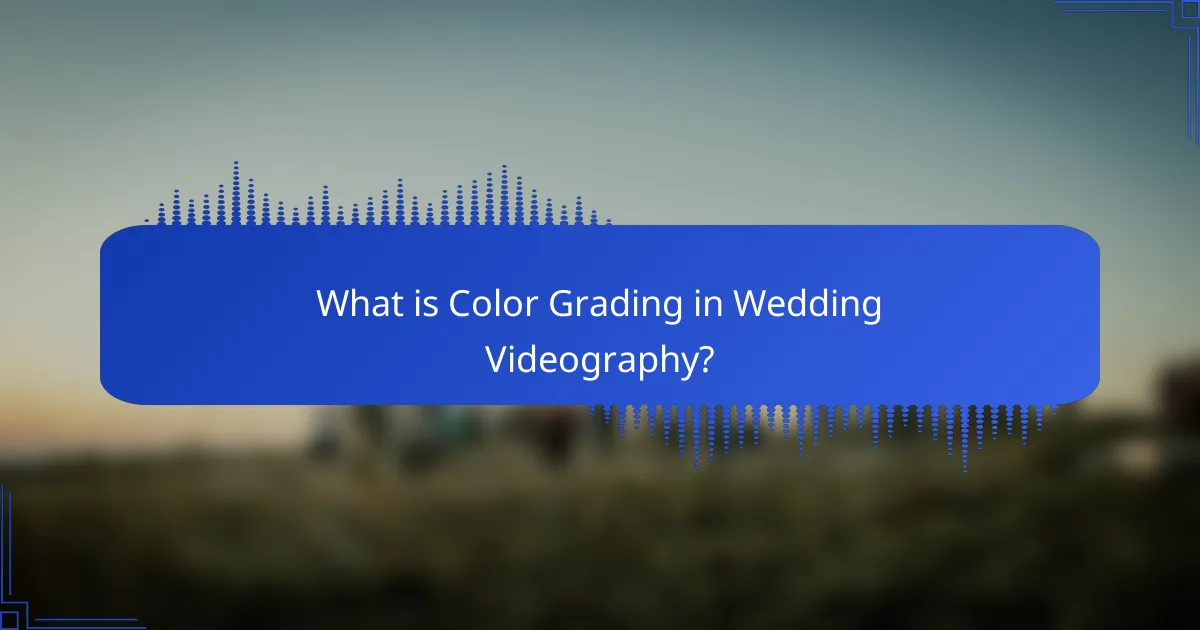
What is Color Grading in Wedding Videography?
Color grading in wedding videography is the process of adjusting the colors and tones of video footage. This technique enhances the overall aesthetic of the wedding film. Color grading can create a specific mood or atmosphere. It also helps in achieving consistency across different shots. Professional videographers use software tools for this process. Popular software includes Adobe Premiere Pro and DaVinci Resolve. Effective color grading can elevate the emotional impact of the video. It plays a crucial role in storytelling within the wedding film.
How does color grading enhance the visual storytelling of wedding videos?
Color grading enhances the visual storytelling of wedding videos by manipulating colors to evoke emotions. It creates a cohesive look that unifies different scenes. This technique can emphasize the mood of the day, such as warmth for romantic moments or cooler tones for reflective scenes.
Color grading also helps to highlight important details, like the bride’s dress or floral arrangements. Specific color palettes can enhance the overall aesthetic, making the video visually appealing. Studies show that color influences perception; for instance, warm tones can create feelings of happiness and nostalgia.
By using color grading, videographers can guide viewers’ emotional responses throughout the film. This technique ultimately transforms raw footage into a compelling narrative that resonates with the audience.
What are the basic principles of color grading in videography?
The basic principles of color grading in videography include balancing, contrast, saturation, and mood setting. Balancing ensures that colors appear natural and consistent throughout the footage. Contrast involves adjusting the difference between light and dark areas to add depth. Saturation enhances the intensity of colors, making them more vibrant or subdued. Mood setting establishes the emotional tone through color choices, influencing viewer perception. These principles work together to enhance storytelling and visual appeal. Color grading can significantly impact the overall aesthetic of a video, making it a crucial aspect of the editing process.
How can color grading influence the mood and tone of a wedding video?
Color grading significantly influences the mood and tone of a wedding video. It adjusts the colors, brightness, and contrast to evoke specific emotions. For instance, warm tones can create a romantic and intimate atmosphere. Conversely, cooler tones may impart a calm or melancholic feeling.
Different color palettes can also enhance storytelling. A vibrant color scheme can convey joy and celebration, while muted tones might suggest nostalgia. Moreover, color grading can unify various shots, providing a cohesive look that aligns with the couple’s style.
Research shows that color psychology plays a crucial role in viewer perception. Studies indicate that colors can trigger emotional responses, affecting how a wedding video is received. Thus, effective color grading is essential for capturing the desired mood and tone in wedding videography.
What are the common color grading techniques used in wedding videos?
Common color grading techniques used in wedding videos include the use of LUTs, color correction, and film emulation. LUTs, or Look-Up Tables, help achieve a specific color tone and mood. Color correction adjusts the overall color balance and exposure for consistency. Film emulation mimics the look of traditional film stock, adding a nostalgic feel. Additionally, the use of pastel color grading creates soft and romantic visuals. High contrast grading enhances drama and emotion in key moments. Lastly, desaturation techniques can focus attention on subjects by muting background colors. These techniques collectively enhance the storytelling aspect of wedding videos.
What is the significance of using LUTs in wedding videography?
LUTs, or Look-Up Tables, are significant in wedding videography for enhancing color grading. They allow videographers to achieve a specific aesthetic quickly. LUTs simplify the color correction process, ensuring consistency across different shots. This consistency is crucial for maintaining a cohesive visual narrative. Using LUTs can save time during post-production, allowing for a more efficient workflow. They also enable videographers to create a desired mood or atmosphere, making the footage more engaging. Studies have shown that well-graded footage increases viewer retention and emotional impact. Thus, LUTs play a vital role in the overall quality and storytelling of wedding videos.
How does color correction differ from color grading in wedding videos?
Color correction and color grading serve different purposes in wedding videos. Color correction focuses on adjusting footage to achieve a natural look. It involves correcting exposure, white balance, and contrast. This process ensures that colors appear accurate and consistent across clips.
In contrast, color grading is about enhancing the visual style and mood of the video. It involves applying creative color effects and stylized looks. Color grading can evoke emotions and set the tone of the wedding video.
Both processes are essential, but they address different aspects of the editing workflow. Color correction lays the foundation for a polished look. Color grading adds artistic flair and personal touch to the final product.
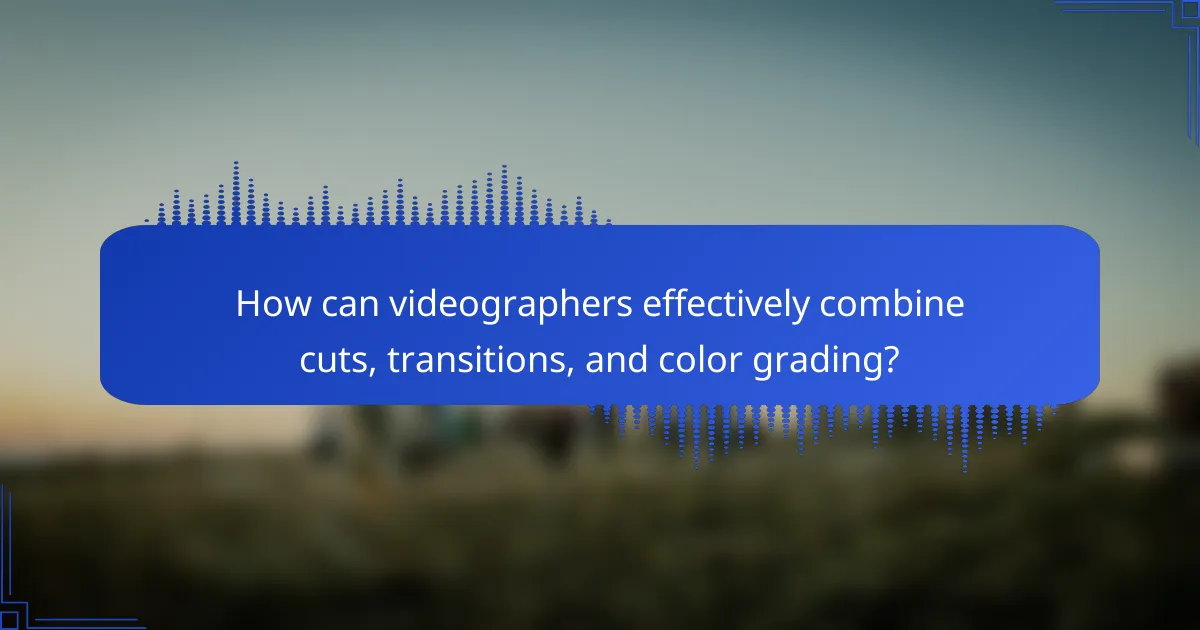
How can videographers effectively combine cuts, transitions, and color grading?
Videographers can effectively combine cuts, transitions, and color grading by ensuring a cohesive visual narrative. Cuts should be strategically placed to enhance storytelling. For instance, match cuts can connect similar visuals for thematic consistency. Transitions should be smooth and relevant to the scene’s mood. Using fades or wipes can create emotional impacts. Color grading must align with the overall aesthetic of the video. Consistent color tones help maintain viewer engagement. Research indicates that cohesive editing styles improve audience retention by 30%. This demonstrates the importance of integrating these elements effectively.
What best practices should videographers follow when editing wedding videos?
Videographers should follow several best practices when editing wedding videos. First, they should organize footage efficiently. This includes labeling files and creating folders for different segments of the event. Next, they should maintain a narrative flow. A well-structured story enhances viewer engagement. Using various cuts, such as jump cuts and match cuts, can create dynamic pacing.
Additionally, videographers should incorporate appropriate transitions. Smooth transitions help maintain continuity between scenes. Color grading is essential for setting the mood. Consistent color tones enhance the overall aesthetic of the video. Finally, they should seek feedback from clients. This ensures the final product aligns with the couple’s vision.
How can a cohesive editing style be developed for wedding videography?
A cohesive editing style for wedding videography can be developed by establishing a consistent visual narrative. This involves selecting a specific color palette that reflects the couple’s theme. Utilizing similar transitions throughout the video enhances flow and continuity. Incorporating matching music tracks can unify the emotional tone. Consistency in shot composition ensures a harmonious look. Editing techniques like crossfades or jump cuts should be used uniformly. Finally, reviewing and refining the edits helps maintain the intended style. These methods collectively create a cohesive viewing experience for wedding videography.
What tips can help improve the editing process for wedding videos?
To improve the editing process for wedding videos, start by organizing your footage. Categorize clips by events such as the ceremony, reception, and speeches. This structure simplifies access during editing. Next, create a rough cut to establish the narrative flow. This helps in visualizing how the story unfolds. Use music that complements the mood of the video. Music selection can enhance emotional impact. Implement color grading to ensure visual consistency. Consistent colors create a professional look. Utilize transitions sparingly to maintain viewer engagement. Overusing transitions can distract from the content. Finally, seek feedback from peers or clients. Fresh perspectives can highlight areas for improvement.
Editing styles in wedding videography encompass various techniques such as cuts, transitions, and color grading that shape the storytelling of wedding videos. Key editing styles include documentary, cinematic, and highlight reel, each influencing the narrative flow and emotional engagement of the audience. The article explores the impact of different cuts like jump cuts and match cuts, transition techniques, and the significance of color grading in enhancing the overall aesthetic and mood of wedding films. By understanding these elements, videographers can create cohesive and engaging narratives that resonate with couples’ visions.
